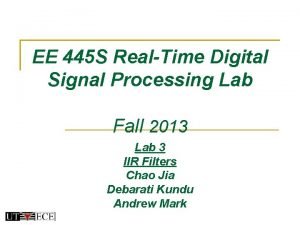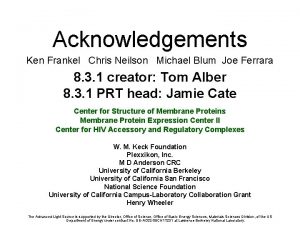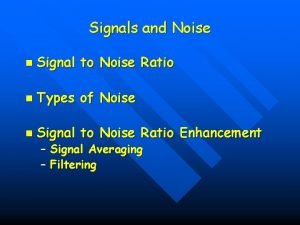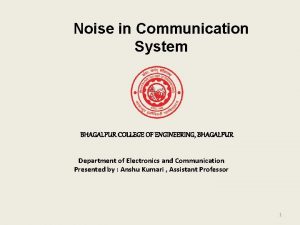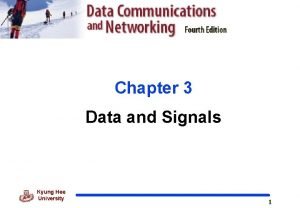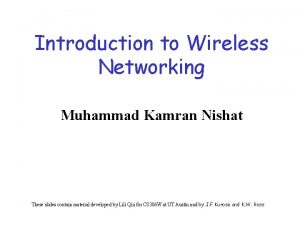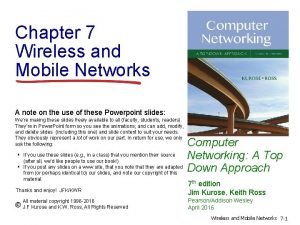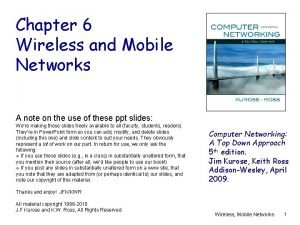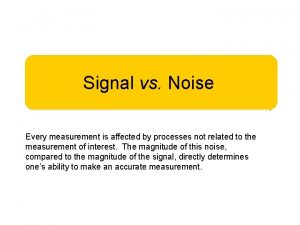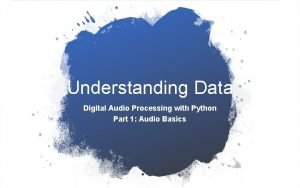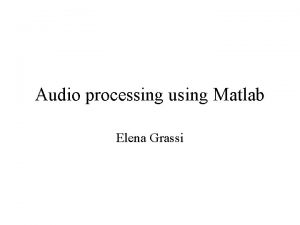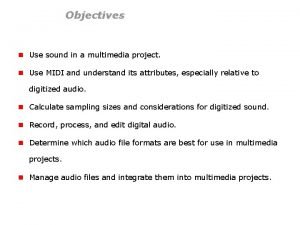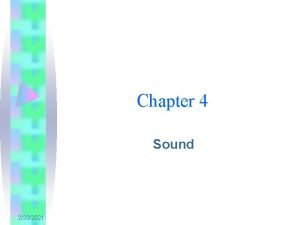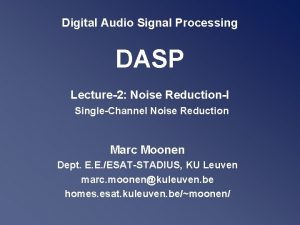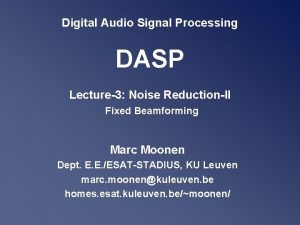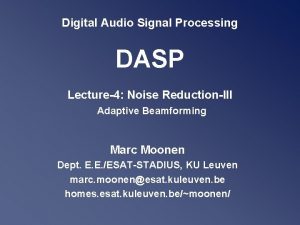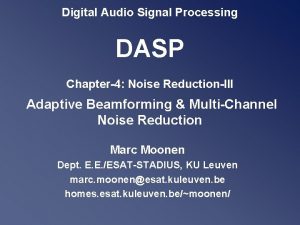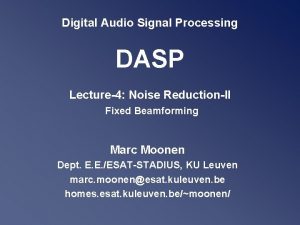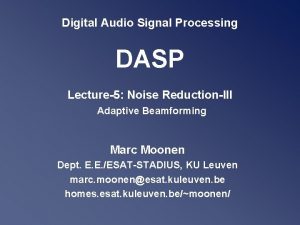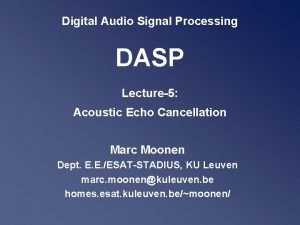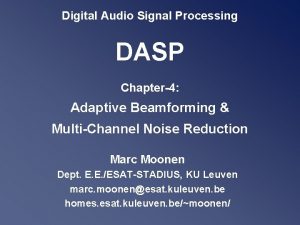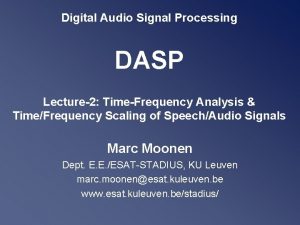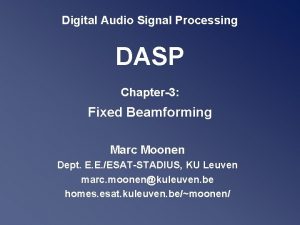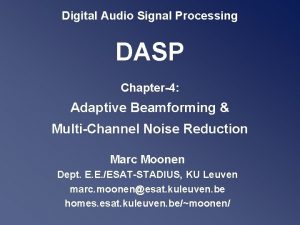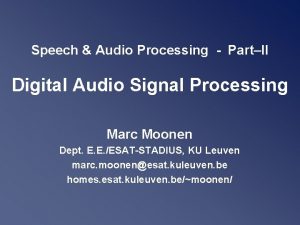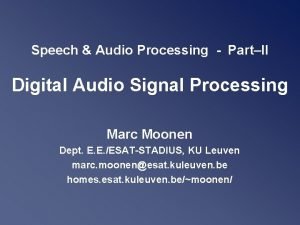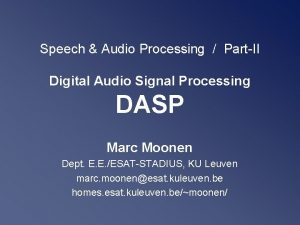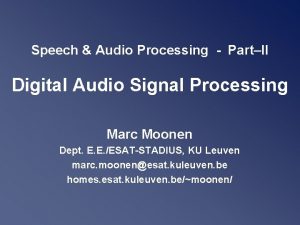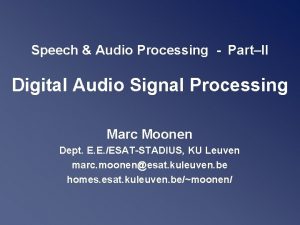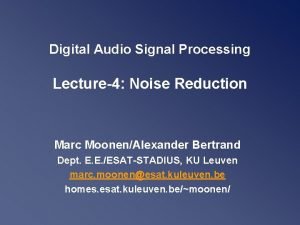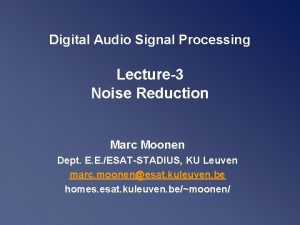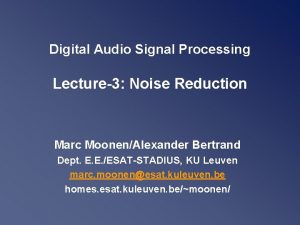Digital Audio Signal Processing DASP Chapter2 SingleChannel Noise

![Single-Channel Noise Reduction • Microphone signal is desired signal s[k] y[k] desired signal noise Single-Channel Noise Reduction • Microphone signal is desired signal s[k] y[k] desired signal noise](https://slidetodoc.com/presentation_image_h/b62ba4e805ebc83c199fccf2228babb0/image-2.jpg)
![Single-Channel Noise Reduction desired signal s[k] y[k] desired signal noise contribution ? desired signal Single-Channel Noise Reduction desired signal s[k] y[k] desired signal noise contribution ? desired signal](https://slidetodoc.com/presentation_image_h/b62ba4e805ebc83c199fccf2228babb0/image-3.jpg)









![Spectral Subtraction: Realization w[k] and v[k] = length-N analysis and synthesis window = prototype Spectral Subtraction: Realization w[k] and v[k] = length-N analysis and synthesis window = prototype](https://slidetodoc.com/presentation_image_h/b62ba4e805ebc83c199fccf2228babb0/image-13.jpg)





![Iterative Wiener Filter Based Noise Reduction For each frame (vector) y[m] 1. Estimate (i=iteration Iterative Wiener Filter Based Noise Reduction For each frame (vector) y[m] 1. Estimate (i=iteration](https://slidetodoc.com/presentation_image_h/b62ba4e805ebc83c199fccf2228babb0/image-19.jpg)




![Kalman Filter Recap 4/4 Kalman Smoother Estimate states x[1], x[2], …, x[T] based on Kalman Filter Recap 4/4 Kalman Smoother Estimate states x[1], x[2], …, x[T] based on](https://slidetodoc.com/presentation_image_h/b62ba4e805ebc83c199fccf2228babb0/image-24.jpg)
![Kalman Filter Based Noise Reduction • Assume AR model of speech and noise u[k], Kalman Filter Based Noise Reduction • Assume AR model of speech and noise u[k],](https://slidetodoc.com/presentation_image_h/b62ba4e805ebc83c199fccf2228babb0/image-25.jpg)
![Kalman Filter Based Noise Reduction Digital Audio Signal Processing s[k] and n[k] are included Kalman Filter Based Noise Reduction Digital Audio Signal Processing s[k] and n[k] are included](https://slidetodoc.com/presentation_image_h/b62ba4e805ebc83c199fccf2228babb0/image-26.jpg)














- Slides: 40

Digital Audio Signal Processing DASP Chapter-2 Single-Channel Noise Reduction Marc Moonen Dept. E. E. /ESAT-STADIUS, KU Leuven marc. moonen@kuleuven. be homes. esat. kuleuven. be/~moonen/
![SingleChannel Noise Reduction Microphone signal is desired signal sk yk desired signal noise Single-Channel Noise Reduction • Microphone signal is desired signal s[k] y[k] desired signal noise](https://slidetodoc.com/presentation_image_h/b62ba4e805ebc83c199fccf2228babb0/image-2.jpg)
Single-Channel Noise Reduction • Microphone signal is desired signal s[k] y[k] desired signal noise contribution ? desired signal estimate noise signal(s) • Goal: Estimate s[k] based on y[k] • Applications: Speech enhancement in conferencing, handsfree telephony, hearing aids, … Digital audio restoration Digital Audio Signal Processing Version 2019 -2020 Chapter-2: Single-Channel Noise Reduction 2/40
![SingleChannel Noise Reduction desired signal sk yk desired signal noise contribution desired signal Single-Channel Noise Reduction desired signal s[k] y[k] desired signal noise contribution ? desired signal](https://slidetodoc.com/presentation_image_h/b62ba4e805ebc83c199fccf2228babb0/image-3.jpg)
Single-Channel Noise Reduction desired signal s[k] y[k] desired signal noise contribution ? desired signal estimate noise signal(s) • Will consider methods that do not rely on a priori information (e. g. expected noise spectrum) • Will consider speech applications: s[k] = speech signal Speech is on/off signal, where speech pauzes can be used to estimate noise spectrum Digital Audio Signal Processing Version 2019 -2020 Chapter-2: Single-Channel Noise Reduction 3/40

Overview • Spectral Subtraction Methods – Spectral subtraction basics (=spectral filtering) – Features: gain functions, realization, musical noise, … • Iterative Wiener Filter Based Noise Reduction • Kalman Filter Based Noise Reduction • Signal Subspace Methods Digital Audio Signal Processing Version 2019 -2020 Chapter-2: Single-Channel Noise Reduction 4/40

Spectral Subtraction Methods: Basics • Signal segmented into `frames’ (e. g. 10. . 20 msec), for each frame a frequency domain representation (=spectrum) is (i-th frame) • However, as speech signal is an on/off signal, some frames have speech+noise, i. e. some frames have noise only, i. e. • A speech detection algorithm (a. k. a. ‘voice activity detection’, VAD) is needed to distinguish between these 2 types of frames (based on energy/dynamic range/statistical properties, …) Digital Audio Signal Processing Version 2019 -2020 Chapter-2: Single-Channel Noise Reduction 5/40

Spectral Subtraction Methods: Basics • Definition: average magnitude of noise spectrum • Assumption: i. e. noise is (short-term) stationary • Hence (also assuming ergodicity) ( ) can be estimated by averaging over noise-only frames (*) • For each frame estimate clean speech spectrum Si( ) by using corrupted speech spectrum Yi( ) together with estimated ( ): based on `gain function’ Digital Audio Signal Processing Version 2019 -2020 Chapter-2: Single-Channel Noise Reduction 6/40

Spectral Subtraction Methods: Basics • PS: Applying a gain function like • can improve signal-to-noise ratio (SNR) of the signal as a whole (i. e. all radial frequencies). . but does not improve the SNR for a particular radial frequency (i. e. speech and noise are equally scaled) • hence impact on speech intelligibility is found to be minimal (or not-existing). . but ‘listening comfort’ is said to be improved For true SNR & speech intelligibility improvement, see multi-channel noise reduction (Chapter 3 -4) Digital Audio Signal Processing Version 2019 -2020 Chapter-2: Single-Channel Noise Reduction 7/40

Spectral Subtraction: Gain Functions Digital Audio Signal Processing Version 2019 -2020 Chapter-2: Single-Channel Noise Reduction 8/40

s Spectral Subtraction: Gain Functions la u m r o 1: Ephraim-Malah Suppression Rule (EMSR) • Example f p i sk with: • • modified Bessel functions This corresponds to a MMSE (*) estimation of the ‘speech spectral amplitude’ |Si( )| based on observation Yi( ) ( estimate equal to E{ |Si( )| | Yi( ) } ) assuming Gaussian a priori distributions for Si( ) and Ni( ) [Ephraim & Malah 1984] Similar formula for MMSE ‘log-spectral amplitude’ estimation [Ephraim & Malah 1985] (*) minimum mean squared error Digital Audio Signal Processing Version 2019 -2020 Chapter-2: Single-Channel Noise Reduction 9/40

Spectral Subtraction: Gain Functions • Example 2: Magnitude Subtraction – Signal model: – Estimation of clean speech spectrum: – PS: half-wave rectification Digital Audio Signal Processing Version 2019 -2020 Chapter-2: Single-Channel Noise Reduction 10/40

Spectral Subtraction: Gain Functions • Example 3: Wiener Estimation – Linear MMSE estimation: find linear filter Gi( ) to minimize MSE – Solution: cross-correlation auto-correlation Assume speech s[k] and noise n[k] are uncorrelated, then. . . – PS: half-wave rectification Digital Audio Signal Processing Version 2019 -2020 =‘instantaneous estimate’ (see also p. 14) Chapter-2: Single-Channel Noise Reduction 11/40

Spectral Subtraction: Realization requires time-frequency analysis (see DSP-CIS Chapter 14) Example: ‘Weigthed Overlap-Add’ (WOLA) based on Short-Time Fourier Transform with analysis/synthesis DFT-modulated filter bank based on analysis and synthesis window Digital Audio Signal Processing Version 2019 -2020 Chapter-2: Single-Channel Noise Reduction 12/40
![Spectral Subtraction Realization wk and vk lengthN analysis and synthesis window prototype Spectral Subtraction: Realization w[k] and v[k] = length-N analysis and synthesis window = prototype](https://slidetodoc.com/presentation_image_h/b62ba4e805ebc83c199fccf2228babb0/image-13.jpg)
Spectral Subtraction: Realization w[k] and v[k] = length-N analysis and synthesis window = prototype defining DFT modulated analysis and synthesis filter bank N = number of filter bank channels = frequency resolution D = downsampling factor = ‘window shift’ (e. g. 2 -fold oversampling: D=N/2, 3 -fold: D=N/3) yn[i] = n-th subband signal = estimate for Y( n ) at time i (i-th frame) G[n, i] = subband processing in n-th subband = gain for n at time i (i-th frame) y[k] Example (N=4, D=2) 2 2 yn[i] x x 2 2 x x Digital Audio Signal Processing Version 2019 -2020 Chapter-2: Single-Channel Noise Reduction + 13/40

Spectral Subtraction: Musical Noise • Audio demo: magnitude subtraction • Artifact: musical noise What? Short-time estimates of |Yi( )| fluctuate randomly in noise-only frames, resulting in random gains Gi( ) statistical analysis shows that broadband noise is transformed into signal composed of short-lived tones with randomly distributed frequencies (=musical noise) Digital Audio Signal Processing Version 2019 -2020 Chapter-2: Single-Channel Noise Reduction 14/40

Spectral Subtraction: Musical Noise Solutions? – Magnitude averaging: replace Yi( ) in calculation of Gi( ) by a local average over frames average instantaneous – EMSR (see p. 9) – Augment Gi( ) with soft-decision VAD: Gi( ) P(H 1 | Yi( )). Gi( ) –… probability that speech is present, given observation Digital Audio Signal Processing Version 2019 -2020 Chapter-2: Single-Channel Noise Reduction 15/40

Overview • Spectral Subtraction Methods – Spectral subtraction basics (=spectral filtering) – Features: gain functions, realization, musical noise, … • Iterative Wiener Filter Based Noise Reduction • Kalman Filter Based Noise Reduction • Signal Subspace Methods Digital Audio Signal Processing Version 2019 -2020 Chapter-2: Single-Channel Noise Reduction 16/40

Iterative Wiener Filter Based Noise Reduction Example of signal model-based spectral subtraction… • Basic: Wiener filtering based spectral subtraction (p. 11), with (improved) spectra estimation based on parametric model • Procedure: 1. Estimate parameters of a speech model from noisy signal y[k] 2. Using estimated speech parameters, perform noise reduction (e. g. Wiener estimation, p. 11) 3. Re-estimate parameters of speech model from the speech signal estimate 4. Iterate 2 & 3 Digital Audio Signal Processing Version 2019 -2020 Chapter-2: Single-Channel Noise Reduction 17/40

Iterative Wiener Filter Based Noise Reduction pulse train voiced … … pitch period unvoiced all-pole filter u[k] speech signal x white noise generator frequency domain: time domain: = linear prediction parameters Digital Audio Signal Processing Version 2019 -2020 Chapter-2: Single-Channel Noise Reduction 18/40
![Iterative Wiener Filter Based Noise Reduction For each frame vector ym 1 Estimate iiteration Iterative Wiener Filter Based Noise Reduction For each frame (vector) y[m] 1. Estimate (i=iteration](https://slidetodoc.com/presentation_image_h/b62ba4e805ebc83c199fccf2228babb0/image-19.jpg)
Iterative Wiener Filter Based Noise Reduction For each frame (vector) y[m] 1. Estimate (i=iteration nr. ) and 2. Construct Wiener Filter (p. 11) Repeat until some error criterion is satisfied with: • • estimated during noise-only periods 3. Filter speech frame y[m] Digital Audio Signal Processing Version 2019 -2020 Chapter-2: Single-Channel Noise Reduction 19/40

Overview • Spectral Subtraction Methods – Spectral subtraction basics (=spectral filtering) – Features: gain functions, realization, musical noise, … • Iterative Wiener Filter Based Noise Reduction • Kalman Filter Based Noise Reduction • Signal Subspace Methods Digital Audio Signal Processing Version 2019 -2020 Chapter-2: Single-Channel Noise Reduction 20/40

Kalman Filter Recap 1/4 State space model of a time-varying discrete-time system process noise measurement noise with v[k] and w[k]: mutually uncorrelated, zero mean, white noises Then: given A[k], B[k], C[k], D[k], V[k], W[k] and input/output-observations u[k], y[k], k=0, 1, 2, . . . then Kalman filter produces MMSE estimates of internal states x[k], k=0, 1, . . . Digital Audio Processing Version 2019 -2020 i. e. x Chapter-2: PS: will. Signal often use shorthand notation, k, yk , . . Single-Channel instead of Noise x[k], Reduction y[k], . . 21/40

Kalman Filter Recap 2/4 Definition: • `FILTERING’ = MMSE-estimate of xk using all available data up until time l = estimate • `PREDICTION’ = estimate • `SMOOTHING’ = estimate Digital Audio Signal Processing Version 2019 -2020 Chapter-2: Single-Channel Noise Reduction 22/40

Kalman Filter Recap 3/4 Initalization: =error covariance matrix ‘Conventional’ Kalman Filter: For k=0, 1, 2, . . Given and corresponding error covariance matrix Step 1: Measurement Update : (produces ‘filtered’ estimate) (compare to standard RLS!) Step 2: Time Update (produces ‘ 1 -step prediction’) Better: ‘Square Root’ Algorithm (see DSP-CIS Chapter 14) Digital Audio Signal Processing Version 2019 -2020 Chapter-2: Single-Channel Noise Reduction 23/40
![Kalman Filter Recap 44 Kalman Smoother Estimate states x1 x2 xT based on Kalman Filter Recap 4/4 Kalman Smoother Estimate states x[1], x[2], …, x[T] based on](https://slidetodoc.com/presentation_image_h/b62ba4e805ebc83c199fccf2228babb0/image-24.jpg)
Kalman Filter Recap 4/4 Kalman Smoother Estimate states x[1], x[2], …, x[T] based on data u[k], y[k], k = 1, …T, T+1, …, N With ‘Conventional’ Kalman Filter: 1. forward run: apply previous equations for k = 1, 2, … N 2. backward run: apply following equations for k = N, N -1, … 1 Result: (better) estimates With ‘Square Root’ Kalman Filter: Full backsubstitution (details omitted) Digital Audio Signal Processing Version 2019 -2020 Chapter-2: Single-Channel Noise Reduction 24/40
![Kalman Filter Based Noise Reduction Assume AR model of speech and noise uk Kalman Filter Based Noise Reduction • Assume AR model of speech and noise u[k],](https://slidetodoc.com/presentation_image_h/b62ba4e805ebc83c199fccf2228babb0/image-25.jpg)
Kalman Filter Based Noise Reduction • Assume AR model of speech and noise u[k], w[k] = zero mean, unit variance, white noise • Equivalent state-space model is… y[k] = microphone signal Digital Audio Signal Processing Version 2019 -2020 Chapter-2: Single-Channel Noise Reduction 25/40
![Kalman Filter Based Noise Reduction Digital Audio Signal Processing sk and nk are included Kalman Filter Based Noise Reduction Digital Audio Signal Processing s[k] and n[k] are included](https://slidetodoc.com/presentation_image_h/b62ba4e805ebc83c199fccf2228babb0/image-26.jpg)
Kalman Filter Based Noise Reduction Digital Audio Signal Processing s[k] and n[k] are included in state vector, hence can be estimated by Kalman Filter with: Version 2019 -2020 Chapter-2: Single-Channel Noise Reduction 26/40

Kalman Filter Based Noise Reduction Iterative algorithm (compare to iterative Wiener Filter) (details omitted) iterations y[k] split signal in frames estimate parameters reconstruct signal Kalman Filter/Smoother i-th frame Disadvantages: • complexity • delay Digital Audio Signal Processing Version 2019 -2020 Chapter-2: Single-Channel Noise Reduction 27/40

Kalman Filter Based Noise Reduction Sequential algorithm (details omitted) iteration index time index (i. e. no iterations) D State Estimator (Kalman Filter) Parameters Estimator (Kalman Filter) D Digital Audio Signal Processing Version 2019 -2020 Chapter-2: Single-Channel Noise Reduction 28/40

Overview • Spectral Subtraction Methods – Spectral subtraction basics (=spectral filtering) – Features: gain functions, realization, musical noise, … • Iterative Wiener Filter Based Noise Reduction • Kalman Filter Based Noise Reduction • Signal Subspace Methods Digital Audio Signal Processing Version 2019 -2020 Chapter-2: Single-Channel Noise Reduction 29/40

Signal Subspace Methods • Signal model: • Construct Toeplitz matrix (Lx. M, N=L+M-1) : Hence: Digital Audio Signal Processing (with S and N similarly constructed) Version 2019 -2020 Chapter-2: Single-Channel Noise Reduction 30/40

Signal Subspace Methods Assumptions: Consider L>>M (‘tall thin’ matrices) – Clean signal matrix S is `rank deficient‘: rank(S) = K < M – Clean signal matrix S is orthogonal (≈uncorrelated) to noise: ST N = 0 – White noise (p. 38 for coloured noise): NT N = 2 noise. IM Assumptions better satisfied as L ∞ Digital Audio Signal Processing Version 2019 -2020 Chapter-2: Single-Channel Noise Reduction 31/40

Signal Subspace Methods Tool: Singular value decomposition (SVD) of Y U is Lx. M orthogonal matrix UT. U=IMx. M Columns of U are ‘left singular vectors’ V is Mx. M orthogonal matrix VT. V=IMx. M Columns of V are ‘right singular vectors’ å is Mx. M diagonal matrix Diagonal elements are ‘singular values’ i 1 has K largest i corresponding to ‘signal+noise subspace’ 2 has M-K smallest I ≈ noise corresponding to ‘noise subspace’ Digital Audio Signal Processing Version 2019 -2020 Chapter-2: Single-Channel Noise Reduction 32/40

Signal Subspace Methods Procedure • Step-1 : From SVD of Y, find estimate of S – Least squares estimate – Minimum variance estimate • Step-2 : Construct Digital Audio Signal Processing Version 2019 -2020 from Chapter-2: Single-Channel Noise Reduction 33/40

Signal Subspace Methods • Step-1 (v 1. 0) : Least squares estimator YLS – Goal: approximate Y by a matrix YLS of rank K – Solution is obtained by setting M-K smallest singular values to zero (`truncation’) – Problem: proper determination of order K Digital Audio Signal Processing Version 2019 -2020 Chapter-2: Single-Channel Noise Reduction 34/40

Signal Subspace Methods • Step-1 (v 2. 0): Minimum variance estimator YMV – Find a matrix T that minimizes (assume S is given, then i-th column of T is optimal linear filter for i-th column of S) – Then: (*) PS : rank-deficiency condition not needed here PS : noise has to be known (e. g. estimated during noise-only) Digital Audio Signal Processing Version 2019 -2020 Chapter-2: Single-Channel Noise Reduction 35/40

Signal Subspace Methods • Step-2 : Signal Reconstruction Goal: Given Problem: , construct does not have Toeplitz structure Solution: Restore Toeplitz structure by arithmetically averaging every diagonal of the matrix Hence: (summation starts in column α) (summation ends in column β) Digital Audio Signal Processing Version 2019 -2020 Chapter-2: Single-Channel Noise Reduction 36/40

Signal Subspace Methods • Audio Demo Subspace Algorithm Digital Audio Signal Processing Version 2019 -2020 Chapter-2: Single-Channel Noise Reduction 37/40

Signal Subspace Methods • PS: What if coloured noise NT N 2 noise. IM ? – Estimate NTN during noise-only periods – Similar procedure, now including ‘pre-whitening’ of Hankel/Toeplitz matrix prior to SVD and ‘de-whitening’ step after estimation of – Computational scheme can use ‘generalized SVD’ instead of SVD (with ‘built-in’ pre-/de-whitening) – Details omitted… Digital Audio Signal Processing Version 2019 -2020 Chapter-2: Single-Channel Noise Reduction 38/40

Signal Subspace Methods • PS: Link with spectral subtraction? – Compare (*) p. 35 with gain function on p. 11 (Wiener) – Interpretation: ‘ Signal subspace method provides a ‘spectral subtraction’ in signal dependent filter bank (analysis filter bank VT, synthesis filter bank V) instead of signal independent WOLA filter bank – Details omitted… Digital Audio Signal Processing Version 2019 -2020 Chapter-2: Single-Channel Noise Reduction 39/40

Conclusion • Many single-channel noise reduction procedures available • Performance never spectacular • Seek performance improvement with multi-channel processing (=Chapter 3 -4) Digital Audio Signal Processing Version 2019 -2020 Chapter-2: Single-Channel Noise Reduction 40/40
 Digital signal as a composite analog signal
Digital signal as a composite analog signal Ladder structure realization of iir filter
Ladder structure realization of iir filter Quantization error formula
Quantization error formula Dr sujan ali
Dr sujan ali Digital signal processing
Digital signal processing Complex wave
Complex wave Digital signal processing
Digital signal processing Digital signal processing
Digital signal processing Digital signal processing
Digital signal processing Digital signal processing
Digital signal processing Digital signal processing
Digital signal processing Digital signal processing
Digital signal processing![What is the z - transform of anu[n] and -anu[-n-1] What is the z - transform of anu[n] and -anu[-n-1]](data:image/svg+xml,%3Csvg%20xmlns=%22http://www.w3.org/2000/svg%22%20viewBox=%220%200%20200%20200%22%3E%3C/svg%3E) What is the z - transform of anu[n] and -anu[-n-1]
What is the z - transform of anu[n] and -anu[-n-1] High-performance digital signal processing
High-performance digital signal processing Digital signal processing
Digital signal processing Signal encoding schemes
Signal encoding schemes Companding quantization
Companding quantization Histogram processing in digital image processing
Histogram processing in digital image processing Neighborhood averaging in image processing
Neighborhood averaging in image processing Neighborhood processing in digital image processing
Neighborhood processing in digital image processing Point processing
Point processing Fractal
Fractal Morphological processing in digital image processing
Morphological processing in digital image processing Frankel signal to noise
Frankel signal to noise S/n ratio
S/n ratio Noise is added to a signal in a communication system *
Noise is added to a signal in a communication system * Baseband and broadband transmission
Baseband and broadband transmission Kamran nishat
Kamran nishat Snr signal to noise ratio
Snr signal to noise ratio Snr signal to noise ratio
Snr signal to noise ratio Signal vs noise
Signal vs noise Python audio processing
Python audio processing Elena grassi
Elena grassi Baseband signal and bandpass signal
Baseband signal and bandpass signal Baseband signal and bandpass signal
Baseband signal and bandpass signal Product of two odd signal is
Product of two odd signal is What is sdars
What is sdars Multimedia data representation
Multimedia data representation Sound in multimedia
Sound in multimedia Vaughan's law of multimedia minimums
Vaughan's law of multimedia minimums Oem digital audio amplifier
Oem digital audio amplifier

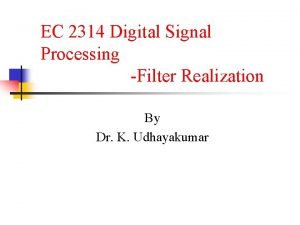
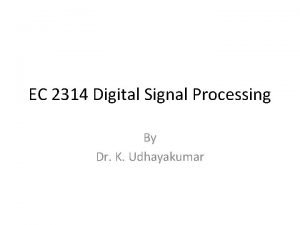
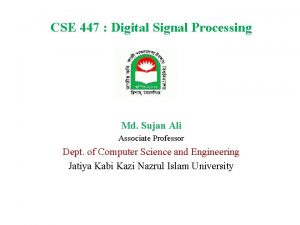
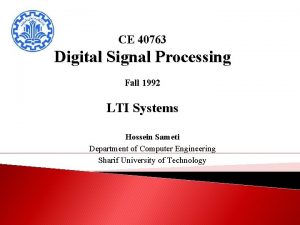
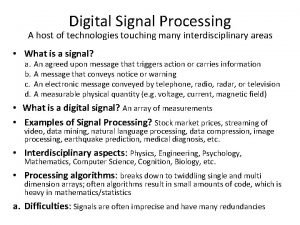
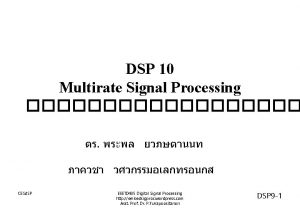
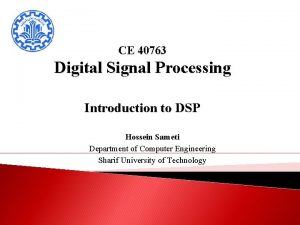
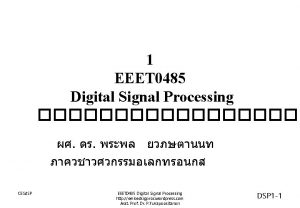
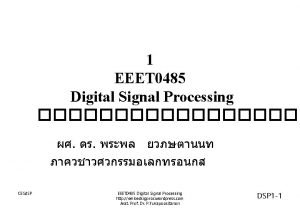
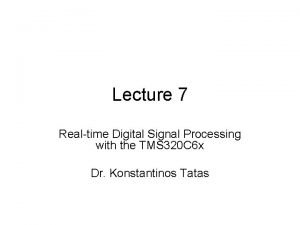
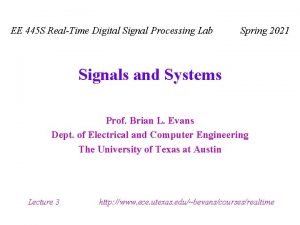
![What is the z - transform of anu[n] and -anu[-n-1] What is the z - transform of anu[n] and -anu[-n-1]](https://slidetodoc.com/wp-content/uploads/2020/12/2676408_bc1105d747f6a28db864208443624449-300x225.jpg)

